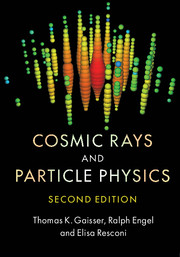Book contents
- Frontmatter
- Contents
- Preface to the first edition
- Preface to the second edition
- 1 Cosmic rays
- 2 Cosmic ray data
- 3 Particle physics
- 4 Hadronic interactions and accelerator data
- 5 Cascade equations
- 6 Atmospheric muons and neutrinos
- 7 Neutrino masses and oscillations
- 8 Muons and neutrinos underground
- 9 Cosmic rays in the Galaxy
- 10 Extragalactic propagation of cosmic rays
- 11 Astrophysical γ -rays and neutrinos
- 12 Acceleration
- 13 Supernovae in the Milky Way
- 14 Astrophysical accelerators and beam dumps
- 15 Electromagnetic cascades
- 16 Extensive air showers
- 17 Very high energy cosmic rays
- 18 Neutrino astronomy
- Appendix
- References
- Index
1 - Cosmic rays
Published online by Cambridge University Press: 05 June 2016
- Frontmatter
- Contents
- Preface to the first edition
- Preface to the second edition
- 1 Cosmic rays
- 2 Cosmic ray data
- 3 Particle physics
- 4 Hadronic interactions and accelerator data
- 5 Cascade equations
- 6 Atmospheric muons and neutrinos
- 7 Neutrino masses and oscillations
- 8 Muons and neutrinos underground
- 9 Cosmic rays in the Galaxy
- 10 Extragalactic propagation of cosmic rays
- 11 Astrophysical γ -rays and neutrinos
- 12 Acceleration
- 13 Supernovae in the Milky Way
- 14 Astrophysical accelerators and beam dumps
- 15 Electromagnetic cascades
- 16 Extensive air showers
- 17 Very high energy cosmic rays
- 18 Neutrino astronomy
- Appendix
- References
- Index
Summary
What are cosmic rays?
Cosmic ray particles hit the Earth's atmosphere at the rate of about 1000 per square meter per second. They are ionized nuclei – about 90% protons, 9% alpha particles and the rest heavier nuclei – and they are distinguished by their high energies. Most cosmic rays are relativistic, having energies comparable to or somewhat greater than their masses. A small but very interesting fraction of them have ultrarelativistic energies extending up to 1020 eV (about 20 joules), eleven orders of magnitude greater than the equivalent rest mass energy of a proton. The fundamental question of cosmic ray physics is, “Where do they come from?” and, in particular, “How are they accelerated to such high energies?”
The answer to the question of the origin of cosmic rays is not yet fully known. It is clear, however, that nearly all of them come from outside the solar system, but from within the Galaxy. The relatively few particles of solar origin are characterized by temporal association with violent events on the Sun and consequently by a rapid variability. In contrast, the bulk of cosmic rays show an anti-correlation with solar activity, being more effectively excluded from the solar neighborhood during periods when the expanding, magnetized plasma from the Sun – the solar wind – is most intense. The very highest energy cosmic rays have gyroradii in typical galactic magnetic fields that are larger than the size of the Galaxy. These may be of extragalactic origin.
Objective of this book
The focus of this book is the interface between particle physics and cosmic rays. The two subjects have been closely connected from the beginning, and this remains true today. Until the advent of accelerators, cosmic rays and their interactions were the principal source of new information about elementary particles. The discovery in 1998 of evidence for neutrino oscillations using the neutrino beam produced by interactions of cosmic rays in the atmosphere is reminiscent of the discoveries of the positron, the muon, the pion and the kaon in the 1930s and 40s. Also, the highest energy cosmic rays can still offer clues about particle physics above accelerator energies, and searches for novel fundamental processes are possible, for example with antiparticles in the cosmic radiation. For the most part, however, cosmic rays are of interest now for the astrophysical information they carry, as reflected by the modern term particle astrophysics.
- Type
- Chapter
- Information
- Cosmic Rays and Particle Physics , pp. 1 - 11Publisher: Cambridge University PressPrint publication year: 2016
- 4
- Cited by

